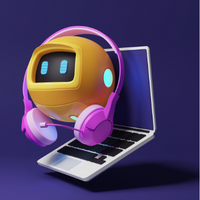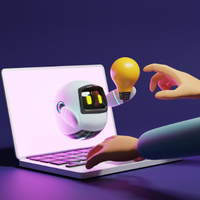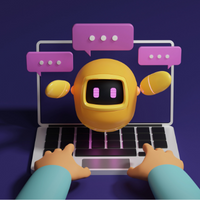Generative IA’s impact on the digital workplace
Artificial intelligence (AI) is rapidly changing the way we work. And, the digital workplace is at the center of this transformation. AI-powered tools are being used to automate tasks, improve decision-making, and provide employees with more personalized experiences. As more companies explore and begin to use generative AI, it’s important to consider the opportunities and risks.
Recently, I had a conversation with a client where we discussed the unrealized potential and opportunity for generative AI to enhance the employee experience. Our conversation focused on AI improving communication and collaboration between the company and employees. Further, AI will impact how employees find information across the enterprise. This is an exciting time in how we communicate and collaborate. Our discussion centered around particular capabilities that have truly captured my interest. I’m looking forward to seeing how they develop and impact the digital workplace. My clients and I are already exploring how we can enhance the employee experience and increase employee engagement with generative AI.
My client, and many of his colleagues, are asking, “how will AI help me? Help my company? And what are the risks associated with AI?” I will leave the risks for a future discussion but I am excited to share my ideas about how generative AI will improve the employee experience.
Generative AI’s place in the digital workplace

As we started our conversation, we focused on where AI is today in the digital workplace. For quite a while, AI has existed in some capacity in the digital workplace. There have been tools available for intranets and collaboration platforms based on the earliest versions of artificial intelligence technology. Intranets have been the biggest users of these tools. While not truly AI, early chatbots have frequently been found within intranets and other commtech platforms.
Today, these tools are often based on scripted responses and provide a glimpse into what could be with generative AI. In the coming years, I expect that AI for the digital workplace will quickly move beyond these capabilities. We are already seeing some platforms support the idea of enhanced discoverability. These intranets help employees find new content and colleagues with the assistance of built in AI tools. AI in today’s digital workplace only scratches the surface of how we can dramatically extend AI’s use and engagement.
Our conversation turned to the exciting future possibilities and how generative AI will transform digital workplace solutions. The coming capabilities will dramatically increase the value and importance of digital workplace platforms.
Let’s explore them.
AI Content Creation

Undeniably, it’s become a common refrain to discuss using AI to create content. Content creation for communications professionals includes:
- copywriting
- research for content
- image creation
- page layout
Of all generative AI capabilities, content creation is already seeing the broadest use in the digital workplace. Using AI, over-taxed communicators are getting new support for content creation, extending their ability to get engaging content in front of employees. Corporate communicators frequently use the most popular generative AI platforms to assist in writing new content. What’s more, original artwork and graphics are also being generated by these and other AI tools specifically built for the task. Bard, Canva, Dall-E and Jasper are just a sampling of the tools rapidly gaining in popularity for content creation.
With generative AI, graphic designers can use well-crafted prompts to create original artwork for infographics and intranet stories. For example, I created one of the graphics in this post using AI. Which one? Take a guess.
Many organizations I work with have lean operations for communications and employee engagement. Introducing generative AI provides an opportunity for these teams to get more done with less. Communications teams creating one or two pieces a week for their intranet can now increase their output and provide more engaging stories for their employees.
An AI Answer Machine

Something I’m referring to as an “answer machine” (as opposed to the old-fashioned answering machine) is an intriguing opportunity for generative AI in the digital workplace. During our discussion, my client was excited by this idea. We both believe it is an important opportunity to add significant value for employees using AI. AI will help us move beyond the search engine many of us like to throw stones at. Generative AI will create a tool that provides real answers; results to our queries will be transformational.
Employees will use AI to look for answers to their questions. They will not only get effective responses, they will get usable material from their queries. We’ll be able to ask the digital workplace for specific, broad results and specify how we want those responses delivered. It won’t be a list of documents. Instead we will receive spreadsheets and slide decks with our answers, ready to deliver to leadership. Generative AI will truly transform the employee experience in the digital workplace. It will combine a company’s proprietary information with publicly available content, and turn that data into content.
A great example of how this might work is the use of AI to understand measurement and metrics. Today, monthly analytics reports contain raw data and require analysis to understand engagement and utilization. In the near future, AI tools will provide answers to our questions:
- How well is our content resonating with employees?
- Is the right content getting to the right audience?
- Where and how are employees consuming content in the digital workplace?
Generative AI will give internal communicators and everyone responsible for employee engagement powerful, meaningful answers to these important questions.
Discoverability

During our discussion, my client and I turned to the idea of discoverability. Discoverability helps people discover people and content that they weren’t aware of.
No matter who you are or your role – especially if you’re in a large organization – you may not know who it is beneficial to connect with or the important content you need to do your job. It’s not a networking or collaboration challenge. It isn’t a people search.
Finding the right colleagues to network and collaborate with inside a company is essential for being effective and efficient. Notably, discoverability has become even more challenging in the age of remote and hybrid working. Yet, generative AI has some solutions.
Today, a number of digital workplace platforms provide some level of discoverability. This ability to find new connections is not limited to people, finding new content is just as valuable. Based on our past activity and current connections, tools can recommend people to connect with/follow and content to read.
AI tools find relationships within content for related factors – titles, copy, others who engaged with content and more.
AI tools can assist in connecting employees with colleagues by analyzing the employee’s network. It can expand their network. Who do the people they know – know? Who is in their hierarchy and also their tangential hierarchy? Generative AI will make discoverability of content and colleagues easier to build and deploy. By turn, this will allow more platforms to include discoverability, making it more capable and reliable.
Given the remote/hybrid aspect of many workplaces, connecting employees with content and colleagues fluidly and intelligently is incredibly valuable. AI will create the new digital workplace water cooler.
Workflow and Automation

I expect AI to add significant value in the digital workplace by supporting the creation of workflows and automation rules. A challenging aspect of CommTech is getting information to the right person at the right time. Leadership or other team members often need to review and approve content prior to publication. New AI tools will dramatically improve how these processes are built and managed. And, allow the information and process owners to create workflows independent of any technical support.
Today, workflow and automation typically require the assistance of an analyst. That is, someone who can take a specification and create those flows. Soon, analysts will tell the generative AI tool to build an information flow for the user. And it will.
AI and Listening?

As a communications leader, my client was very interested in the opportunity to increase employee listening across the organization. It’s critical for them to understand the questions, challenges and sentiments that employees are experiencing. Today, it requires concerted efforts, including feedback tools, polls and other measures to collect this data. AI provides an opportunity to have always-on measuring and feedback.
These platforms will be able to monitor the engagement tools and levels across all communication channels. They will be able to quickly assess the positive and negative sentiments across the company. Reports can be delivered unprompted. Alerts, warnings and positive notices can be created in the moment by generative AI tools. This dramatic improvement in employee listening will prove to be a significant change in how communications teams engage with employees. Understanding the nuances of how employees behave and feel while active in the digital workplace will facilitate positive engagement.
The Future is Smart

Our conversation culminated in two key questions – when and how?
“When” is a bit of now and a bit of TBD.
We are already seeing some of these important capabilities in sophisticated digital workplace solutions. Others may take a bit longer but advances are happening rapidly. Almost all of the vendors in this space are adding AI capabilities to their platforms, some at a very rapid pace. Microsoft has launched Copilot, other vendors are adding content creation AI capabilities. While there’s no clear roadmap for when and how the AI tools above will fully make their way into every digital workplace, I expect the pace to accelerate rapidly. Within the next two years, few, if any, digital workplace platforms will not include some element of generative AI.
“How” is multifaceted.
How will these tools be used? In all of the ways I have discussed above. But also, with controls in place and understanding for how information is used and shared. We asked, “how will these tools be deployed into the digital workplace?”
My projection is they will be fairly seamlessly integrated into most tools. In many instances, the employees using these capabilities will not take any extra steps to access them. They will just be there. For example, all organizations running Microsoft 365 now have access to their Copilot AI tool.
I see a near-term future where generative AI is available in all digital workplaces. I believe it will be available in large complex multi-channel environments. Small and medium-sized businesses operating less complex digital workplace environments will also take advantage of the power of AI.
Let’s talk!

I can promise you a human conversation about generative AI in the digital workplace. Or, actually, anything else regarding communication technology platforms strategy. Oh, by the way, I created the “woman listening” graphic using Canva’s AI capability. Other graphics created by ©lerbank-bbk22/Canva.
Got questions? Drop me a note or grab some time with me. Let’s talk!
You know what else is smart?
Our 2023 Integral Index. It’s our national study of ~2,000 US employees. It sheds light on employee experience and the state of the workplace. This year, we’re releasing the study in five parts, about three weeks apart. Over the coming weeks, we’ll share our findings and analysis of how an organization’s actions drive employee experience, engagement, and activation.
